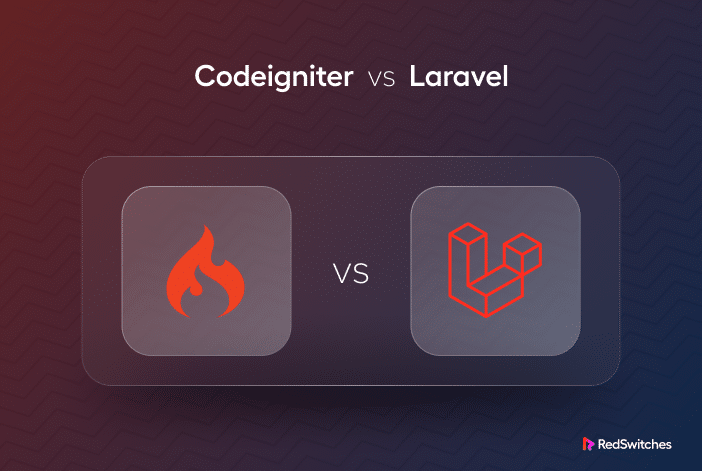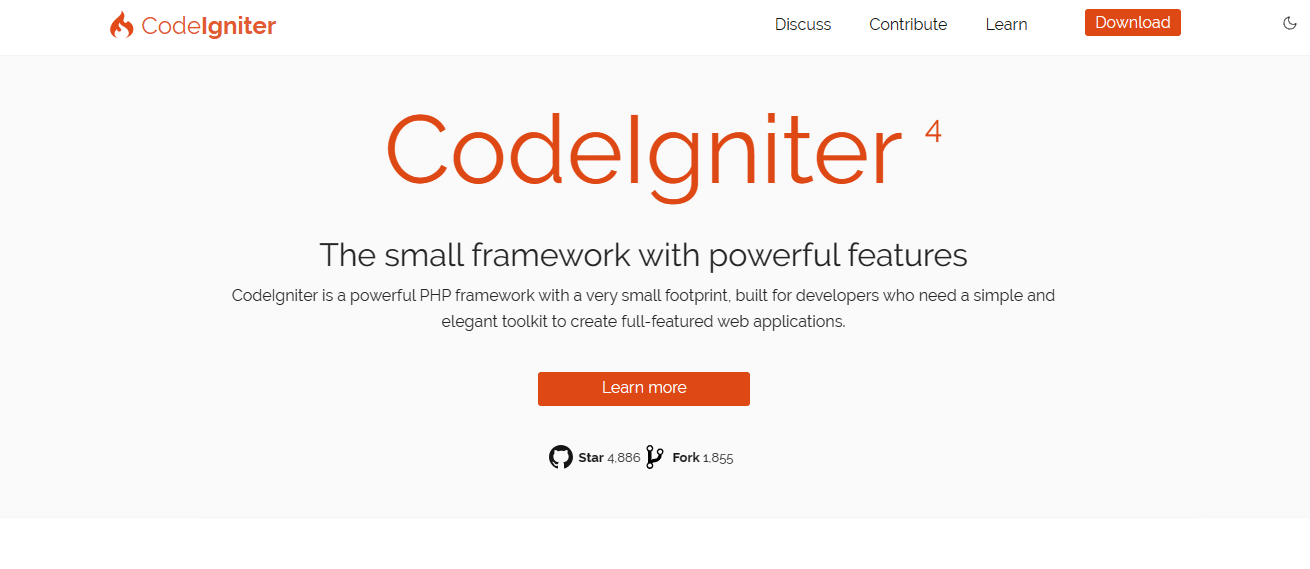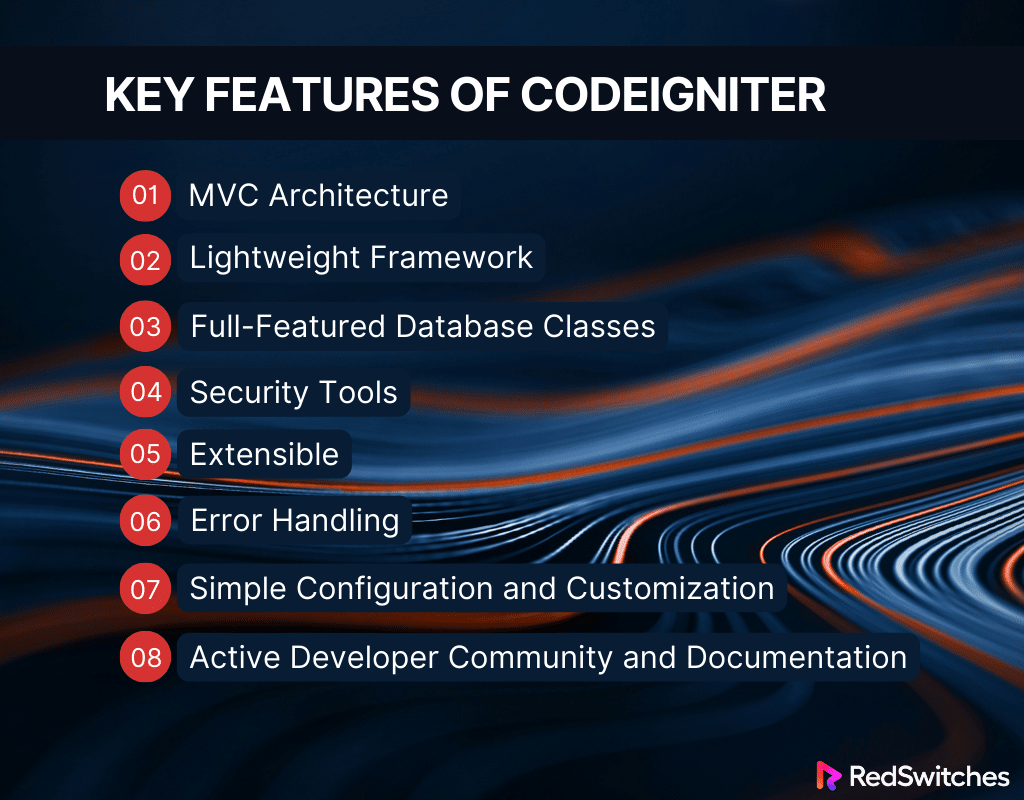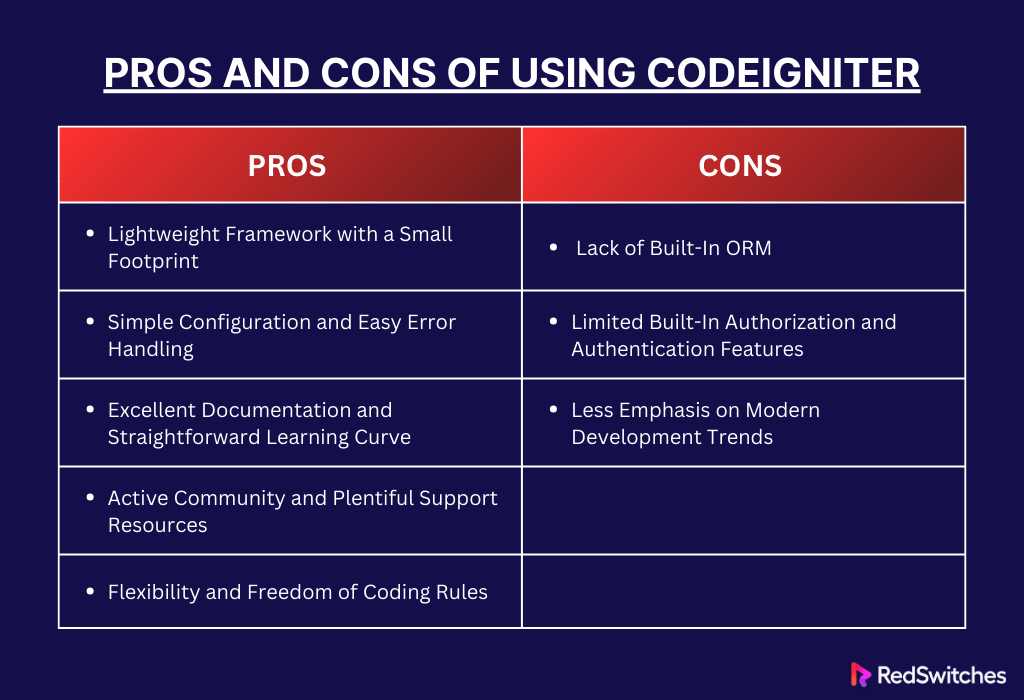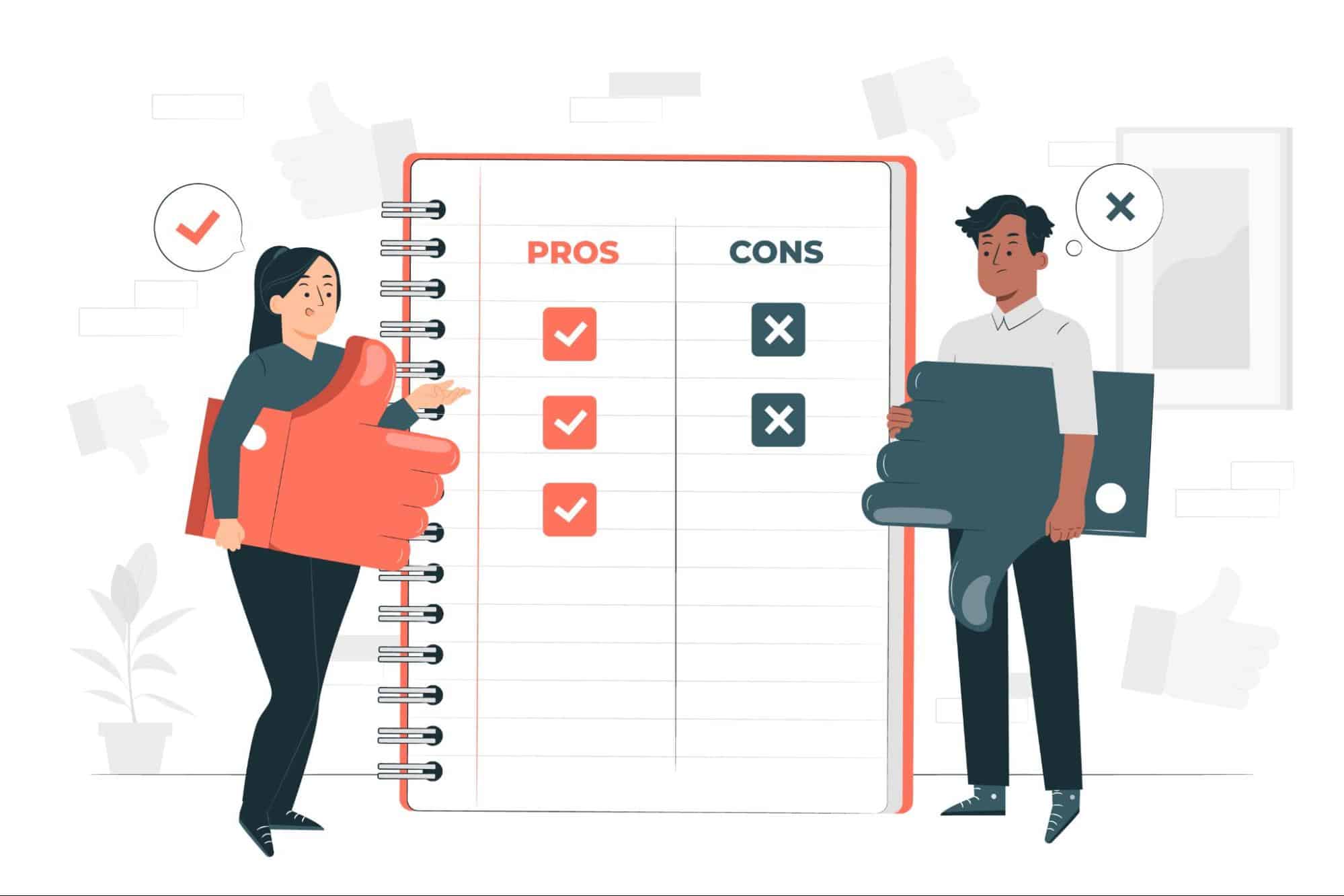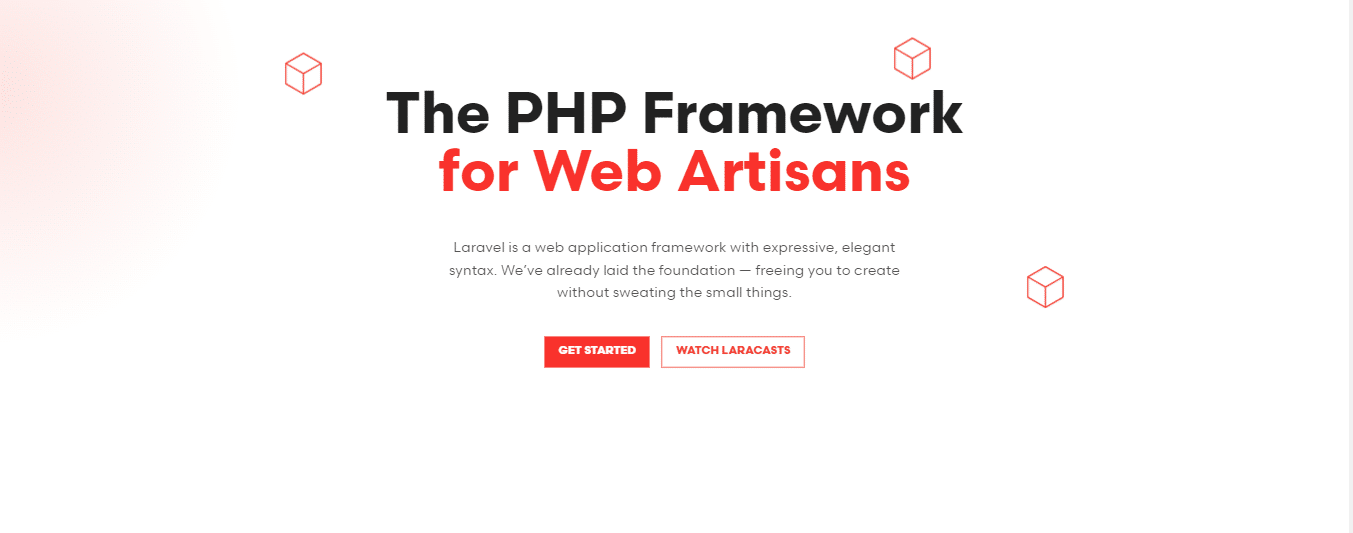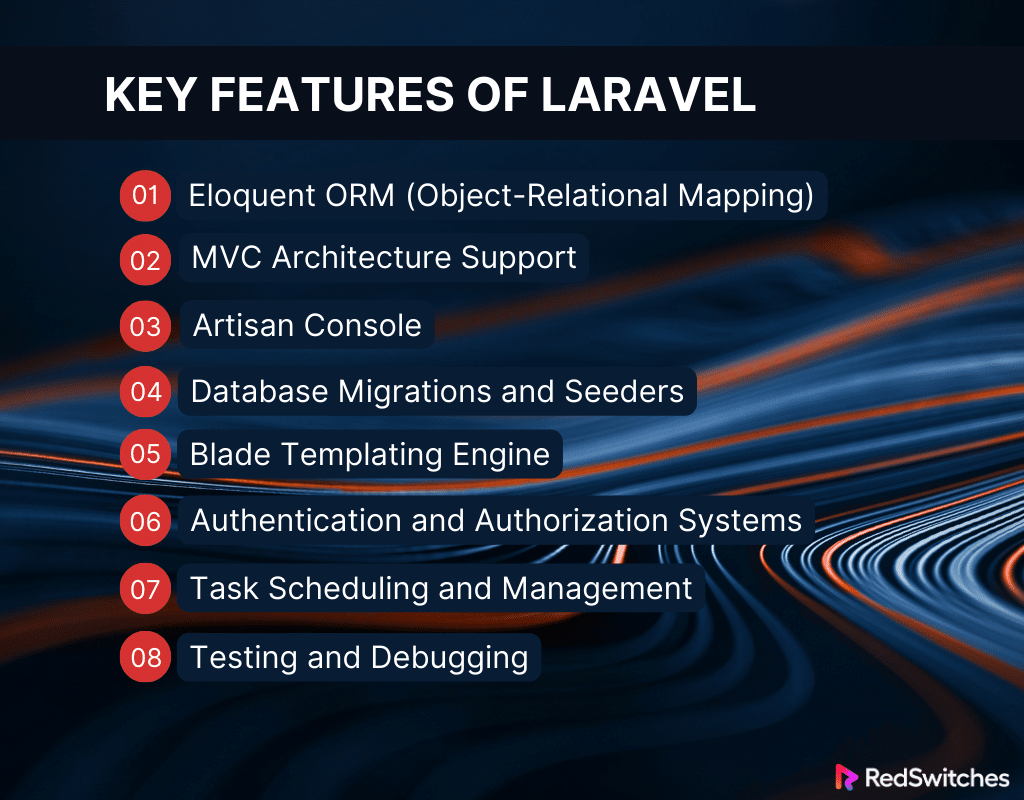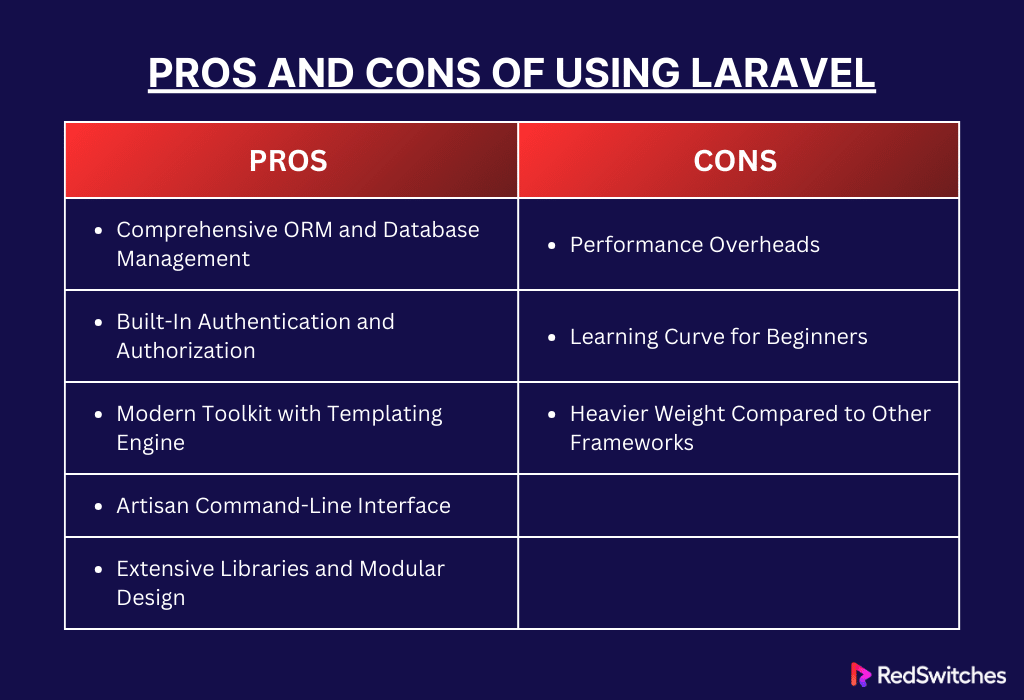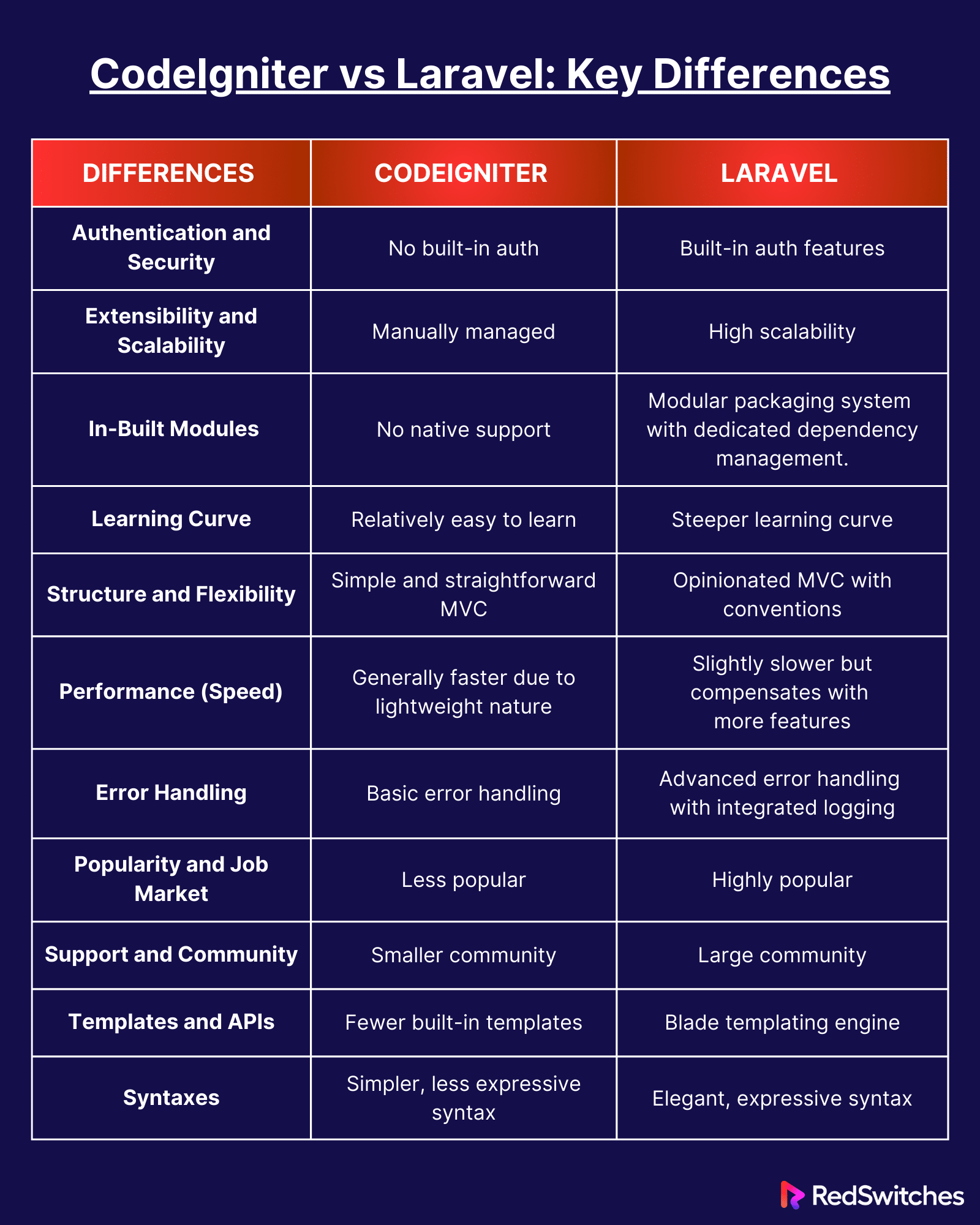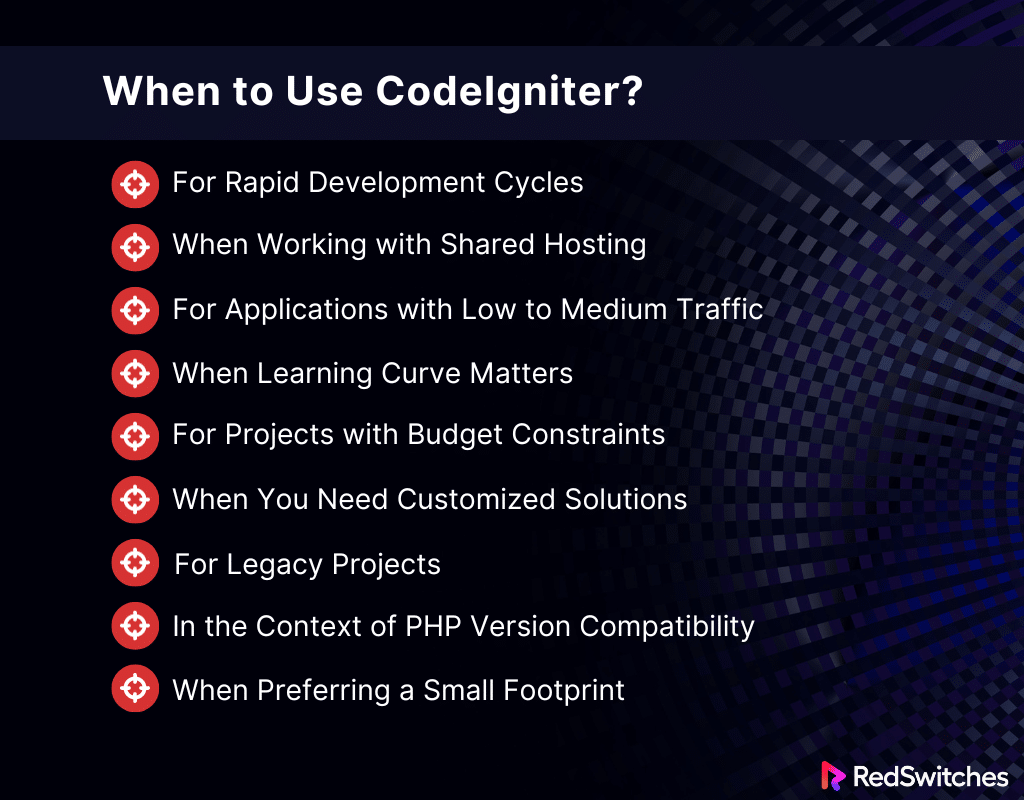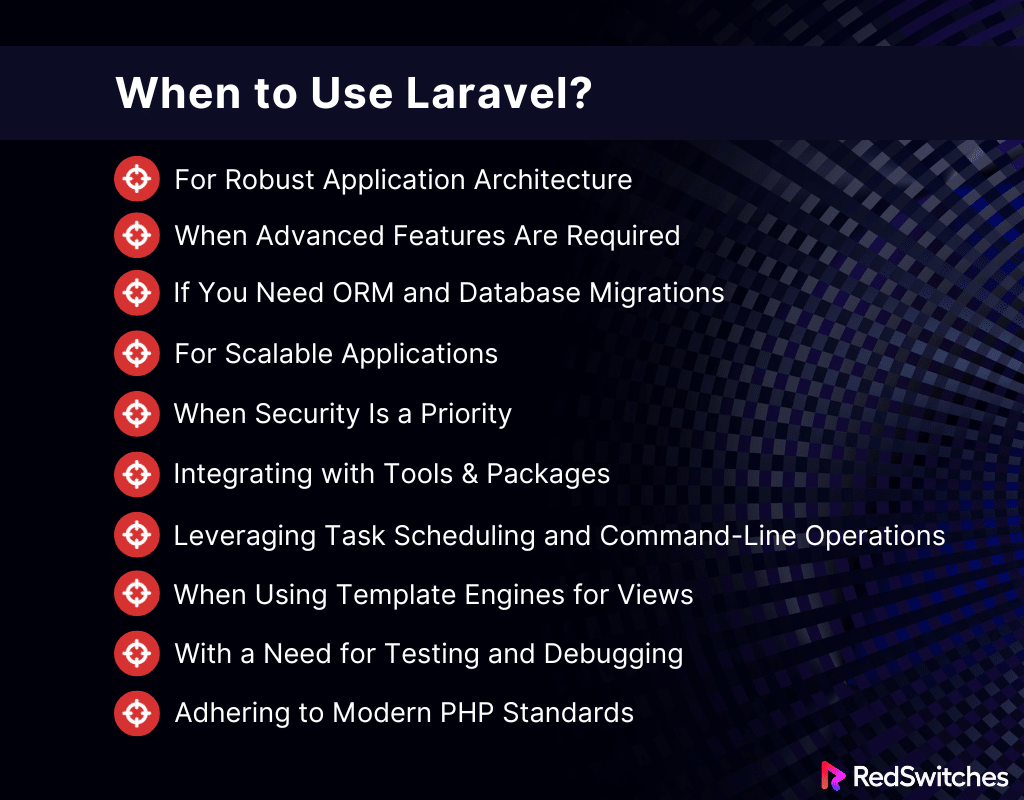When considering frameworks for web development, two names, Laravel and Codeigniter, emerge as the most prominent PHP frameworks, each with unique capabilities. While CodeIgniter is known for its simplicity and lightweight nature, Laravel is celebrated for its elegance and comprehensive features.
According to BuiltWith, Laravel is used by approximately 704,255 sites, capturing around 3.79% of the leading 10K site market. Meanwhile, CodeIgniter powers around 487,713 websites and claims 1.47% of the leading 10K site market. These statistics are proof of the powerful presence and impact these frameworks’ have in the world of web development.
This blog will take you through a comparison between Codeigniter and Laravel. It will also explore their core features, pros and cons, and use cases, offering in-depth insight into the differences between Codeigniter vs Laravel.
Table Of Contents
- What Is CodeIgniter?
- What Is Laravel?
- CodeIgniter vs Laravel: A Head-to-Head Comparison
- When to Use CodeIgniter?
- For Rapid Development Cycles
- When Working with Shared Hosting
- For Applications with Low to Medium Traffic
- When Learning Curve Matters
- For Projects with Budget Constraints
- When You Need Customized Solutions
- For Legacy Projects
- In the Context of PHP Version Compatibility
- When Preferring a Small Footprint
- When to Use Laravel?
- For Robust Application Architecture
- When Advanced Features Are Required
- If You Need ORM and Database Migrations
- For Scalable Applications
- When Security Is a Priority
- Integrating with Tools & Packages
- Leveraging Task Scheduling and Command-Line Operations
- When Using Template Engines for Views
- With a Need for Testing and Debugging
- Adhering to Modern PHP Standards
- Conclusion
- FAQs
What Is CodeIgniter?
Credits: CodeIgniter Website
Before we explore a comparison of CodeIgniter vs Laravel, it is essential to discuss the individual definitions of each.
CodeIgniter is a popular open-source PHP framework known for being lightweight and easy to use yet powerful enough for creating full-featured web applications. It boasts a nearly zero-configuration approach, making it an attractive choice for developers who want to avoid the complexity of larger frameworks.
CodeIgniter offers a comprehensive set of libraries for commonly needed tasks. It comes with a simple interface and logical structure to access these libraries. It’s designed to be fast, focusing on performance and minimizing the code needed for a given task. The framework uses the Model-View-Controller (MVC) architectural pattern, but it allows for flexibility, allowing developers to build applications in a way that suits them best.
Key Features of CodeIgniter
Exploring the critical features of CodeIgniter can offer significant information on choosing between CodeIgniter vs Laravel for your needs. Below are the key features that make CodeIgniter an attractive option for PHP developers.
MVC Architecture
CodeIgniter employs the Model-View-Controller (MVC) architectural design, which separates the application logic from the presentation layer. This structure allows developers to work on individual components without affecting the others, streamlining the development process.
The MVC framework ensures that the database-driven models, the user interface views, and the application controller are independently maintained. This makes the code more modular, convenient to manage, and scalable.
Lightweight Framework
One of CodeIgniter’s most compelling features is its lightweight nature. The core system of the framework requires minimal resources compared to other PHP frameworks, ensuring a minimal impact on your server’s performance. This light footprint makes CodeIgniter an excellent choice for developers looking to maximize efficiency without sacrificing functionality.
Full-Featured Database Classes
CodeIgniter has full-featured database classes that support traditional structures and Query Builder patterns. These classes make database tasks simple and developer-friendly, supporting numerous database platforms.
Whether you are executing basic queries or crafting complex ORM models, CodeIgniter offers a consistent interface to interact with different types of databases smoothly.
Security Tools
CodeIgniter rises to the challenge of maintaining security with its built-in security tools. The framework offers features such as input and XSS filtering and supports the creation of token-based CSRF protection mechanisms. These tools help developers to protect their web applications from various security threats with less manual effort.
Extensible
The framework is designed to be easily extensible. If the core library doesn’t have the functionalities needed for a specific task, developers can create their libraries or helpers, extending the native features of CodeIgniter. This extensibility ensures that CodeIgniter can evolve with the needs of your project, adapting to new requirements or integrating third-party plugins with ease.
Error Handling
Handling errors is straightforward with CodeIgniter. It provides a simple user interface to detect and manage errors throughout the application lifecycle. The built-in error logging class lets developers display errors directly on the screen, save them to a log file, or even email them. This helps quickly identify and resolve issues that may arise during development or production.
Simple Configuration and Customization
Getting started with CodeIgniter is a breeze thanks to its hassle-free configuration. Most of the framework’s behavior can be adjusted through simple configuration files. The clear documentation makes customizing and extending the framework’s capabilities a straightforward process for developers of all skill levels.
Active Developer Community and Documentation
CodeIgniter includes a robust and highly active developer community. This is an asset for both new and experienced users. With extensive and clear documentation, developers can find guidance and share solutions to common problems. Community-driven support can be invaluable when tackling unique challenges or grasping best practices.
Also Read: Python vs PHP: How To Choose The Best Language For Your Projects?
Pros and Cons of Using CodeIgniter
When choosing between CodeIgniter vs Laravel, one must weigh in the pros and cons of each to understand which framework offers the most benefits for you. Below are the pros and cons of CodeIgniter:
Pros
Lightweight Framework with a Small Footprint
CodeIgniter is praised for being lightweight. The framework is just a few megabytes in download size, including the user guide. This small footprint means that it’s swift when it comes to performance, a critical factor for developers who are conscious of improving the speed of their applications.
By avoiding the bloat of features not always necessary for every project, CodeIgniter allows for creating web applications that load quickly, offering a better user experience.
Simple Configuration and Easy Error Handling
One of the fundamental advantages of using CodeIgniter is its simplicity of configuration. The framework is almost ready to run after a straightforward installation, with minimal configuration needed.
CodeIgniter’s error handling is easy to understand and use, making debugging tasks much less time-consuming. Developers can easily display errors across the web application, which helps quickly identify and fix issues in the development phase.
Excellent Documentation and Straightforward Learning Curve
CodeIgniter boasts some of the best documentation available for any framework. Each release comes with a comprehensive user guide that is easily accessible and well-structured, aiding developers in learning how to use the framework efficiently.
This, coupled with its simple syntax and logical structure, flattens the learning curve, making it an excellent choice for beginners or those who wish to develop projects quickly without a steep learning investment.
Active Community and Plentiful Support Resources
CodeIgniter has a solid and active community due to its long history in the web development realm. Numerous forums, dedicated websites, and groups offer support, tips, and free-to-use scripts to help solve problems developers might encounter. This means that help is readily available, ensuring that developers won’t be stuck when they face challenges, which can be incredibly reassuring for new developers.
Flexibility and Freedom of Coding Rules
CodeIgniter is less prescriptive than other frameworks, offering developers more flexibility and freedom regarding coding rules. It does not force MVC (Model-View-Controller) patterns, empowering developers to build applications as they see fit. This freedom is ideal for developers who like to write code with fewer restrictions. This can lead to more creative and tailored solutions for complex web applications.
Also, Read The Ultimate Guide to Install Composer on Ubuntu 22.04.
Credits: FreePik
Cons
1. Lack of Built-In ORM
CodeIgniter does not come with a built-in Object-Relational Mapping (ORM). While it does have a Query Builder, it’s not as powerful as an ORM, which can be a major drawback for developers who prefer the Active Record pattern for data manipulation. Although there are third-party ORMs that can be integrated with CodeIgniter, it adds additional steps and complexity to the development process.
2. Limited Built-In Authorization and Authentication Features
CodeIgniter does not ship with built-in authentication and authorization features. This can be viewed as a disadvantage because these are common requirements in modern web applications. Developers often rely on third-party libraries or build these features from scratch, which can be time-consuming and potentially introduce security risks if not implemented correctly.
3. Less Emphasis on Modern Development Trends
As a framework that has been around for quite some time, CodeIgniter has been criticized for not keeping pace with modern web development trends, like RESTful support, or including newer PHP features like namespaces and anonymous functions in its core structure. While it has evolved to include these features in later versions, it is still seen as lagging behind newer frameworks built with these trends in mind.
Do you want to learn how to install phpMyAdmin on Ubuntu? Read our informative blog, ‘Install phpMyAdmin on Ubuntu: A Beginner’s Step-by-Step Guide.’
Who Uses CodeIgniter?
Below are a few use cases of Codeigniter:
Small to Medium Businesses
Small to medium-sized enterprises (SMEs) often turn to CodeIgniter due to its straightforward setup and minimal configuration requirements. It enables businesses with limited resources to deploy web applications quickly and efficiently without requiring extensive developer teams.
Educational Institutions and Students
Educational entities and students frequently use CodeIgniter for learning purposes and to build projects due to its simple learning curve and well-documented nature. The framework’s approachability helps those new to programming concepts grasp web development more readily.
Freelancers and Independent Developers
Freelancers and independent developers prefer CodeIgniter when working on projects that require rapid development and deployment. The framework’s ease of use and flexibility allow for quick turnaround without getting bogged down by overly complex programming conventions.
Startups
Startups choose CodeIgniter for creating prototypes or getting their products to market quickly due to its ability to accommodate fast-paced development cycles. The framework’s performance efficiency is particularly beneficial for startups looking to optimize their web applications for speed and agility.
Web Development Agencies
Many web development agencies keep CodeIgniter in their toolkit for its reliability and mature ecosystem. These agencies value the framework’s long-term stability and robustness for various web projects.
What Is Laravel?
Credits: Laravel Website
Laravel is a powerful PHP framework curated for web artisans, offering expressive and elegant syntax. It is known for its diverse features that include everything from an ORM (Eloquent) to event handling and authentication.
Laravel aims to make the development process a pleasing one for developers without sacrificing application functionality. With its focus on back-end development, Laravel has tools to streamline tasks like database migrations, unit testing, seeding, etc.
It also encourages using a templating engine called Blade, which is intuitive and allows for tasks like data formatting and layout inheritance without the overhead of PHP opening and closing tags. Laravel follows the Model-View-Controller (MVC) design pattern and provides a clean API for most web server functionalities.
Also Read: Laravel vs Angular: Decoding the Web Development Duel
Key Features of Laravel
Exploring the key features of Laravel can offer insight on which is more suitable between CodeIgniter vs Laravel for your individual needs. Below are a few key features that make Laravel an attractive PHP framework:
Eloquent ORM (Object-Relational Mapping)
Laravel’s Eloquent ORM provides an active record implementation that makes it incredibly easy to interact with database objects and relationships using expressive, fluent syntax. It supports almost all database operations and is highly optimized for performance, which makes dealing with database transactions as simple as working with PHP classes and methods.
MVC Architecture Support
Laravel is built on the MVC (Model-View-Controller) architectural pattern, ensuring clarity between logic and presentation. This organization allows for clean and maintainable code, making it easy for developers to work on large-scale applications with a well-structured and modular approach. MVC support helps improve performance, allowing better documentation, and has multiple built-in functions for increased efficiency of development tasks.
Artisan Console
The Artisan console is Laravel’s command-line interface with many commands to help automate tedious programming tasks. Developers can also extend the functionality of Artisan by creating their commands for repetitive tasks, which significantly speeds up the development process. This tool helps with database migrations, testing, and running jobs, which is vital for modern web application development.
Database Migrations and Seeders
Laravel’s migration system helps maintain and control database versions and share the database schema. It’s like version control for your database, allowing teams to modify and share the application’s database schema without hassle. Seeders in Laravel populate the database with sample data, essential for testing and setting up initial data structures.
Blade Templating Engine
Blade is a simple yet powerful templating engine provided with Laravel, which doesn’t restrict you from using plain PHP code in your views. It compiles the templates into plain PHP code for optimal performance and provides convenient shortcuts for common PHP functions. Blade also offers template inheritance and sections, allowing for more expressive and manageable layouts.
Authentication and Authorization Systems
Laravel makes implementing authentication very simple. It includes configuration for user registration, login, and password reset. Beyond authentication, Laravel provides an easy-to-use and customizable authorization system that gates actions and permissions in a straightforward and organized manner.
Task Scheduling and Management
With Laravel’s task scheduling, repetitive tasks like sending out emails or database cleanups can be easily managed and scheduled within the framework. This eliminates the need for an additional task scheduling server and reduces overhead by allowing for fluent and expressive defining of command schedules within the Laravel framework. Task management is streamlined with the help of unified APIs over queue services.
Testing and Debugging
Laravel is built with testing in mind. It supports PHPUnit out of the box and provides helpful methods for simulating basic behaviors. The framework also includes a variety of convenient helper methods, allowing for expressive testing of applications, while its robust debugging tools help developers quickly identify and fix issues.
Pros and Cons of Using Laravel
When choosing between CodeIgniter vs Laravel, one must evaluate the pros and cons of each to determine which framework offers the most benefits. Below are the pros and cons of Laravel:
Pros
Comprehensive ORM and Database Management
Laravel comes with Eloquent, an ORM that is powerful and expressive, allowing for complex data operations and relationships using simple and elegant syntax. This alleviates the need for writing SQL queries for most database interactions, significantly speeding up the development process.
Built-In Authentication and Authorization
Laravel provides robust authentication and authorization systems, making it easy to set up secure sign-ups and access control for your applications. These features are not only comprehensive but are also customizable to fit varied requirements.
Modern Toolkit with Templating Engine
Laravel includes Blade, a templating engine that introduces a cleaner way to manage your HTML and systematize templates across projects. It’s intuitive and helps create a rich layout system with dynamic content seeding.
Artisan Command-Line Interface
The Artisan CLI, a built-in tool provided by Laravel, offers a suite of commands that assist in automating tedious programming tasks. Developers can also extend its functionality by adding custom commands and streamlining the workflow.
Extensive Libraries and Modular Design
Laravel’s ecosystem provides a wide range of pre-built libraries and modules that can be easily integrated to add application functionality. This modularity allows for scalable and maintainable code management.
Credits: FreePik
Cons
Performance Overheads
Although Laravel offers many features, these can introduce performance overheads compared to lighter frameworks. Applications may require optimization, such as caching and fine-tuning, to achieve high performance.
Learning Curve for Beginners
Newcomers to Laravel may face a steeper learning curve due to its extensive functionalities and advanced features. Understanding and utilizing the framework fully requires a more in-depth learning commitment.
Heavier Weight Compared to Other Frameworks
Laravel is heavier than many other PHP frameworks, which may not be ideal for developers looking to build lightweight applications or those with limited server resources. This can impact the deployment and operational costs of the application.
Are you contemplating between web server vs application server? Read our blog, ‘Web Server vs Application Server: How To Pick The Right Platform For Your Operations,’ to make an informed decision.
Who Uses Laravel?
Below are a few use cases of Laravel:
Startups
Startups favor Laravel for its rapid development capabilities and extensive library of packages that accelerate the deployment of innovative features. The framework’s emphasis on elegant syntax and advanced functionalities like queue management makes it highly suitable for agile development environments.
Tech Companies
Tech companies often choose Laravel for building complex, high-load web applications due to its ability to handle large-scale projects efficiently. Its built-in tools for caching, session management, and authentication streamline the development process and ensure scalability.
E-commerce Platforms
E-commerce businesses use Laravel to create scalable, secure online shopping platforms. The framework’s robust security features, easy integration with payment gateways, and eloquent ORM for database transactions make it a popular choice for online merchants.
Content Management Systems (CMS)
Organizations requiring custom content management systems opt for Laravel because of its flexible structure that can be tailored to specific content workflows. Laravel’s MVC architecture and expressive templating engine allow for the creation of unique and dynamic CMS solutions.
Educational Institutions
Educational institutions and e-learning platforms use Laravel to create custom, secure, and interactive web applications. Laravel’s straightforward approach to handling complex data relationships and built-in user authentication features are particularly beneficial for educational web resources.
CodeIgniter vs Laravel: A Head-to-Head Comparison
Comparing CodeIgniter vs Laravel in terms of differences can offer a wealth of information on Codeigniter vs Laravel, which is better for your individual needs. Below is a comparison of CodeIgniter vs Laravel:
CodeIgniter vs Laravel: Authentication and Security
Below is a comparison of the difference between CodeIgniter vs Laravel in terms of authentication and security:
CodeIgniter
CodeIgniter provides a solid base for authentication but doesn’t include built-in auth features. This means developers must write their own authentication code or integrate third-party libraries. Security-wise, CodeIgniter comes with features that help prevent CSRF, XSS, and SQL injection attacks. It relies heavily on the developer to manually implement these features properly.
Laravel
Laravel has a significant advantage with its built-in authentication system, which is part of its philosophy to make common tasks hassle-free. With features like password reset, encryption, and user authentication readily available, it’s easier to get started on secure applications. Laravel also emphasizes security, providing robust protection against risks.
CodeIgniter vs Laravel: Extensibility and Scalability
Below is a comparison of the difference between CodeIgniter vs Laravel in terms of extensibility and scalability:
CodeIgniter
CodeIgniter is known for its small footprint and lean approach to coding, which can be ideal for smaller projects and applications where minimalism and speed are critical. It’s relatively extensible with third-party plugins, but scaling requires more manual effort and tuning from the developer.
Laravel
Laravel shines in the extensibility and scalability department. With its built-in support for various development environments and a dependency manager that handles package control, it’s easier to extend the functionality of your applications. Laravel’s Eloquent ORM and event handling allow for a scalable structure that can grow with your application’s needs.
CodeIgniter vs Laravel: In-Built Modules
Below is a comparison of the difference between CodeIgniter vs Laravel in terms of in-built modules:
CodeIgniter
CodeIgniter does not support in-built modularity natively. Developers can create modules but must adhere to an MVC pattern and manage them through hooks or third-party packages, which can be a bit cumbersome and time-consuming.
Laravel
Laravel comes with a modular packaging system with dedicated dependency management. This makes it easy to add pre-packaged modules and allows developers to create modular applications that are easier to maintain and scale. Laravel’s service container is a powerful tool for managing class dependencies and performing dependency injection.
CodeIgniter vs Laravel: Learning Curve
Below is a comparison of the difference between CodeIgniter vs Laravel in terms of learning curve:
CodeIgniter
CodeIgniter is often praised for its straightforwardness and simplicity. New developers find it approachable because of its clear documentation and the fact that it doesn’t enforce a strict coding paradigm. Its lightweight nature means there’s less to learn upfront. This can lead to a quicker project start for beginners or those looking to migrate from pure PHP.
Laravel
Laravel is known for its elegant syntax, but with elegance comes complexity. The learning curve is steeper than CodeIgniter due to its advanced features like routing, middleware, ORM, and templating engine. For those willing to climb the curve, Laravel offers expressive coding practices and features that facilitate robust web application development.
CodeIgniter vs Laravel: Structure and Flexibility
Below is a comparison of the difference between CodeIgniter vs Laravel in terms of structure and flexibility:
CodeIgniter
CodeIgniter’s structure is straightforward and doesn’t impose as many restrictions on developers, granting them the flexibility to structure their applications as they see fit. This flexibility can be a double-edged sword; it allows experienced developers to craft applications to their exact specifications but can lead to issues with maintainability as projects grow.
Laravel
Laravel follows the model-view-controller (MVC) architecture strictly and comes with a more opinionated structure. It provides a standardized way of building web applications, which is beneficial for maintaining code quality and consistency across large teams and projects. Laravel’s framework is also highly flexible. Its IoC container empowers it, making it easy to implement custom solutions when the features do not meet the developer’s needs.
Credits: FreePik
Codeigniter vs Laravel: Performance (Speed)
Below is a comparison of the difference between CodeIgniter vs Laravel in terms of performance:
CodeIgniter
Performance is one of CodeIgniter’s strongest suits. It is renowned for its speed, especially in shared hosting and other environments with limited resources. Its minimalistic design means less overhead, potentially faster response times, and lower memory consumption.
Laravel
Laravel, while providing an extensive feature set, does so with some trade-offs in raw execution speed. It’s heavier than CodeIgniter due to its sophisticated functionality. Laravel’s performance is not to be underestimated, especially when leveraging caching and other optimization techniques within the framework.
CodeIgniter vs Laravel: Error Handling
Below is a comparison of the difference between CodeIgniter vs Laravel in terms of error handling:
CodeIgniter
Error handling in CodeIgniter is straightforward. It offers built-in functions for logging errors, which developers can use to display or hide error messages. The error handling can be controlled by adjusting the configuration settings, which makes it somewhat flexible. It’s generally considered less sophisticated than in some more modern frameworks.
Laravel
Laravel is built with error and exception handling baked into the framework through its integration with the Monolog logging library, which supports various powerful log handlers. Laravel automatically handles exceptions and presents them in a clean, elegant format that can be customized. It’s built to comply with the PSR-3 logging standard, making error logs more standardized and easy to interpret.
CodeIgniter vs Laravel: Popularity and Job Market
Below is a comparison of the difference between CodeIgniter vs Laravel in terms of popularity and job market:
CodeIgniter
While CodeIgniter has been a favorite among PHP developers for its simplicity and speed, it has declined in popularity with the advent of frameworks like Laravel. Consequently, the job market for CodeIgniter-specific roles may be more niche, attracting businesses and developers with existing projects in CodeIgniter or prefer its lightweight architecture.
Laravel
Laravel has surged in popularity due to its modern features, elegant syntax, and robust capabilities. It has become one of the most starred PHP frameworks on GitHub, which indicates a strong following. This popularity translates into a vibrant job market for Laravel developers. Companies looking for scalable and modern web applications often seek developers with Laravel expertise, making it a valuable skill in the PHP community.
CodeIgniter vs Laravel: Support and Community
Below is a comparison of the difference between CodeIgniter vs Laravel in terms of support and community:
CodeIgniter
CodeIgniter’s support and community are substantial. It has a dedicated forum, an active user guide, and several third-party resources for support. Compared to Laravel, the community might be less active, especially regarding contributions to the framework’s development or the availability of tutorials for the latest development trends.
Laravel
Laravel’s community is among the most active and vibrant in the PHP ecosystem. It has extensive documentation and many tutorials available and enjoys a high level of community engagement through forums, Discord channels, and local user groups. The framework’s open-source nature encourages contributions and has a thriving ecosystem of packages available through Packagist.
CodeIgniter vs Laravel: Templates and APIs
Below is a comparison of the difference between CodeIgniter vs Laravel in terms of templates and APIs:
CodeIgniter
CodeIgniter has a basic templating engine that allows developers to embed PHP code directly into HTML. While this may be sufficient for simple views, it lacks the power and convenience of modern templating engines. For API development, CodeIgniter requires you to handle most of the heavy lifting manually, which can be good if you need custom solutions but might slow development otherwise.
Laravel
Laravel boasts Blade, a powerful yet easy-to-use templating engine that combines one-way data binding with inheritance and caching, leading to elegant, readable templates and reduced server load. Laravel simplifies API development through RESTful routing and its resource controllers. With Laravel, you also benefit from Eloquent, an ORM that makes database interactions and CRUD operations in APIs more intuitive.
CodeIgniter vs Laravel: Syntaxes
Below is a comparison of the difference between CodeIgniter vs Laravel in terms of syntaxes:
CodeIgniter
CodeIgniter’s syntax is praised for being simple and straightforward. It follows the MVC (Model-View-Controller) pattern, and developers can quickly pick up the framework without learning any new template language. CodeIgniter’s syntax can feel verbose and outdated, mainly when dealing with modern development practices.
Laravel
Laravel’s syntax is expressive and elegant, using modern PHP features such as anonymous functions and namespaces. It also provides syntactic sugar that can make common tasks more readable and maintainable. Laravel’s Eloquent ORM, in particular, offers an almost conversational style of database interaction, which is both powerful and developer-friendly.
Do you want to learn more about popular server-side scripting languages? Read our informative blog here.
When to Use CodeIgniter?
Credits: FreePik
When determining between CodeIgniter vs Laravel, it is important to understand that both PHP frameworks can have varying use cases. Below are a few scenarios where CodeIgniter can serve as a suitable web framework:
For Rapid Development Cycles
CodeIgniter’s minimalist setup and convention over configuration philosophy mean that you can go from concept to prototype in a concise amount of time. It’s ideal for small businesses or individual developers who need to quickly produce a functional product without getting bogged down by overly complex programming requirements.
When Working with Shared Hosting
CodeIgniter is lightweight and does not require the latest PHP version or command-line access, making it well-suited for shared hosting environments. This framework can be a lifesaver for projects operating within limited server capabilities.
For Applications with Low to Medium Traffic
Thanks to its lean nature, CodeIgniter is an excellent choice for websites and applications that expect low to medium traffic. It can deliver performance without extensive server resources, thus serving as an ideal platform for startups and small to mid-sized projects.
When Learning Curve Matters
CodeIgniter’s simplicity allows for quick onboarding for teams with beginner to intermediate PHP skills or when project timelines are tight. Its clear documentation and straightforward approach make learning easy, reducing the time it takes to become productive.
For Projects with Budget Constraints,
CodeIgniter’s low learning curve and efficiency mean less time (and therefore money) is spent on development and maintenance. This makes it a sound choice for businesses with strict budgetary limits but still need a robust and reliable web application.
When You Need Customized Solutions,
CodeIgniter is flexible and doesn’t impose strict software development patterns. This is particularly useful when you need to create highly customized solutions or deal with unconventional project requirements.
For Legacy Projects
If you’re working on a legacy project built using CodeIgniter, sticking with it for updates or expansions is often the most pragmatic approach. Switching frameworks can introduce unnecessary complexity and potential compatibility issues.
In the Context of PHP Version Compatibility
CodeIgniter has long been praised for its backward compatibility with older PHP versions. It’s a good choice for developers who may be constrained by hosting environments that do not support the latest PHP features.
When Preferring a Small Footprint
If you prefer a framework that doesn’t have the overhead of features you may never use, CodeIgniter’s small footprint is ideal. It provides just enough functionality to build capable web applications without overwhelming the developer with unused features.
Also Read: Webflow vs WordPress: The Future of Web Design in 2024.
When to Use Laravel?
Credit: iStock
When deciding between CodeIgniter vs Laravel, it is important to understand that each PHP framework can be used for varying purposes. Below are a few scenarios where Laravel can serve as a suitable web framework:
For Robust Application Architecture
When your project requires a solid architectural foundation, Laravel is an ideal choice. It follows the Model-View-Controller architecture, which brings clarity and structure to the development process, making it easier to maintain and scale the application over time.
When Advanced Features Are Required
If you anticipate the need for complex functionalities like user authentication, routing, session management, or intricate data relationships, Laravel provides out-of-the-box solutions. Its built-in tools and libraries can handle many advanced features that are otherwise time-consuming.
If You Need ORM and Database Migrations
Laravel’s Eloquent ORM is one of the most advanced ORM systems available, offering an active record implementation for working with your database. Laravel’s migration system helps maintain database consistency and allows you to version-control your database schema, which is crucial for collaborative environments.
For Scalable Applications
Laravel’s queue management handles tasks in the background, improving performance and resource management for applications demanding scalability. Various caching systems and integrations with cloud storage providers back its scalability.
When Security Is a Priority
Security is a prominent feature of Laravel, which offers protection against common threats such as SQL injection, cross-site request forgery, and cross-site scripting. Laravel’s security features are integrated into its architecture, ensuring a secure foundation for your application.
Integrating with Tools & Packages
Laravel’s extensive ecosystem includes a wide range of tools and packages, including Laravel Nova, Echo, and Horizon, which extend its capabilities even further. When you need to integrate with these tools or use Composer packages, Laravel’s built-in support makes the process seamless.
Leveraging Task Scheduling and Command-Line Operations
Laravel’s command-line interface, Artisan, provides several helpful commands for automating repetitive tasks. Laravel’s built-in command scheduler can manage cron jobs from within the framework if your application relies on task scheduling.
When Using Template Engines for Views
Laravel’s Blade templating engine is intuitive and helps create dynamic HTML layouts with minimal fuss. If your project requires complex layouts with extensive use of view templates, Blade makes the process efficient and manageable.
With a Need for Testing and Debugging
With Laravel, you get built-in testing support with PHP Unit and various helpful testing methods specific to Laravel. This is essential for applications where rigorous testing is necessary to maintain code integrity and reliability.
Adhering to Modern PHP Standards,
Laravel adheres to modern PHP standards and practices, including Composer for package management, PSR standards, and the latest PHP features. This makes it a future-proof choice for applications that need to stay current with web development best practices.
Conclusion
Choosing between PHP frameworks can be as challenging as exciting. Our head-to-head comparison of CodeIgniter vs Laravel shows how Codeigniter stands out for its straightforward approach, simplicity, and speed, while Laravel, with its robust features, stands out for applications that demand a sophisticated and feature-rich environment.
The foundation a PHP framework provides is only as strong as the infrastructure it’s built upon. This is where RedSwitches offers tailored hosting solutions optimized for both CodeIgniter and Laravel applications. With our reliable performance, robust security measures, and dedicated support, your web application can achieve new heights of efficiency and scalability.
So what are you waiting for? Visit RedSwitches today to see how we can accelerate your project’s success and give you the peace of mind that comes with a secure and well-supported online presence.
FAQs
Q. Which is better, CodeIgniter or Laravel?
When considering CodeIgniter vs Laravel, the better choice depends on your project requirements and your team’s expertise. Laravel is generally preferred for large-scale applications due to its extensive features, built-in functions, and emphasis on elegant syntax and modern development principles. CodeIgniter is ideal for projects where a lightweight framework and a smaller learning curve are advantageous.
Q. Is Codeigniter still relevant in 2024?
Yes, CodeIgniter remains relevant in 2024 for developers looking for a straightforward, no-frills PHP framework. While it may not have as many built-in features as Laravel, its ease of use and performance efficiency make it suitable for certain projects, particularly those that require a small footprint and simple implementation.
Q. Why Laravel is more popular than CodeIgniter?
In the debate of CodeIgniter vs Laravel, Laravel is more popular because it offers a more robust ecosystem, which includes comprehensive authentication, object-relational mapping, a powerful migration system, and a strong focus on clean, readable syntax. Its large community, extensive packages, and resources for developers contribute to its popularity, making Laravel a go-to for many modern web applications.
Q. What is the difference between Laravel and CodeIgniter?
Laravel is a more modern and powerful PHP framework compared to CodeIgniter. It offers features such as a more expressive syntax, built-in authentication and authorization, and a powerful ORM. On the other hand, CodeIgniter is known for its simplicity and easy learning curve, making it a good choice for small to medium-sized projects.
Q. Which is the best choice between Laravel and CodeIgniter in 2024?
The choice between Laravel and CodeIgniter in 2024 depends on the specific project requirements. If you need a robust framework with advanced features and scalability, Laravel may be the best choice. However, if you prioritize simplicity and ease of use, CodeIgniter could be the better option.
Q. What are the benefits of using Laravel over CodeIgniter?
Laravel offers several advantages over CodeIgniter, including a more modern and expressive syntax, built-in tools for authentication, authorization, and testing, an active and supportive community, and powerful ORM for database interactions.
Q. Is Laravel the best PHP framework in 2024?
Laravel is widely considered one of the best PHP frameworks in 2024 due to its advanced features, modern design patterns, and strong community support. However, the decision of the best framework ultimately depends on the specific project requirements and developer preferences.
Q. What are the key features of Laravel framework?
Laravel framework is known for its powerful features such as MVC architecture, expressive syntax, Eloquent ORM, Blade templating engine, built-in authentication and authorization, Artisan command-line interface, and robust testing support among others.
Q. How does CodeIgniter compare to Laravel as a PHP framework?
CodeIgniter is known for its simplicity, ease of learning, and lightweight footprint, making it suitable for small to medium-sized projects. On the other hand, Laravel offers more advanced features, a modern and expressive syntax, and a larger ecosystem of libraries and extensions.
Q. Which one is easier to use, Laravel or CodeIgniter?
CodeIgniter is generally considered easier to learn and use, especially for beginners, due to its simpler and more straightforward approach. On the other hand, Laravel may have a steeper learning curve but provides more powerful and modern features for experienced developers.
Q. Can CodeIgniter be used for custom extensions?
Yes, CodeIgniter allows the creation of custom extensions and libraries to extend its functionality as per specific project requirements. This flexibility makes it suitable for developing custom solutions for diverse web applications.
Q. Which PHP framework is more popular, Laravel or CodeIgniter?
Both Laravel and CodeIgniter are popular PHP frameworks, each with its own strengths and target use cases. Laravel is favored for its modern features and scalability, while CodeIgniter is popular for its simplicity and lightweight nature.
Q. What are the key differences between Laravel and CodeIgniter?
The main differences between Laravel and CodeIgniter lie in their complexity, feature set, and development approach. Laravel provides a more modern, feature-rich environment with strong community support, while CodeIgniter offers simplicity and ease of use for smaller projects.
